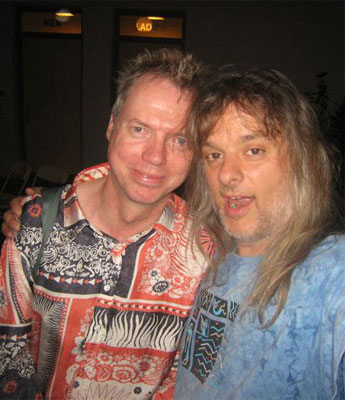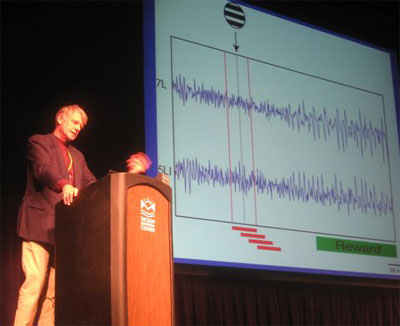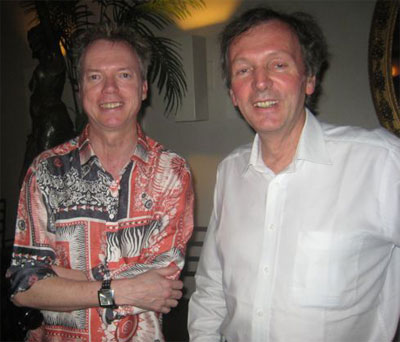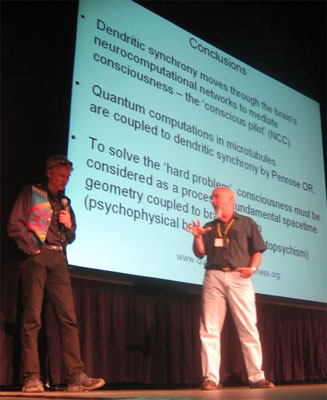 Andy Clark, Dave Chalmers |
 Wolf Singer All photos: Dave Chalmers |
 |
 |
| Andy Clark, Rupert Sheldrake |
Christof Koch, Stuart Hameroff |
Tucson 2008
Blogged by John Derbyshire
National Review Online, April 9-13, 2008
Edited by Andy Ross
Wednesday, April 9
We started with a discussion of Benjamin Libet's astonishing results. He
showed that neurophysiologically speaking, your intention to do something
precedes the conscious decision to do it. First, Bill Banks (experimental
psychologist) and Francesca Carota (neuroscientist) presented some
worthy-but-dull quantitative stuff.
John Jacobson (philosopher and
information scientist) described his work at creating an unbeatable
rock-paper-scissors computer program, throwing out all sorts of witty and
penetrating observations on free will, "folk volition" (what we rubes think
volition is all about, as opposed to what it is really all about), and
something called pessimistic indeterminism.
Physicist Daniel Sheehan
(University of California, San Diego) gave us a physicist's account of the
nature of time. Down at the quantum level, things get radically weird, we
all know that. He believes brain processes partake of the weirdness.
Sheehan offered some startling experimental results that seemed to show
presentiment. You show your suspect a blank screen, then you randomly
display a picture, either an "emotional" one, that will evoke a strong
neuro-response (such as a naked woman) or a "calm" one (a seascape). Then
you quickly go back to the blank screen. You are monitoring neural reactions
all the time. The "emotional" pictures produce not only a strong reaction
after they are shown but also a measurably stronger reaction before being
shown.
Sheehan claims he can explain this via known quantum effects,
and says the explanatory power you get by bringing quantum weirdness into
biology makes it worthwhile.
Susan Pockett (University of Auckland,
New Zealand) doubted Libet's famous results, saying he'd made unjustifiable
assumptions. She pooh-poohed Sheehan's quantum weirdness, arguing that there
were less-strange explanations for the phenomena. She scoffed at the
"presentiment" experiment, mocking its statistics.
Andy Clark
(University of Edinburgh) gave an address on the "extended mind." This is
the notion that, as he put it, "skin and skull are porous." He says a
person's mind can fairly be taken to include things other than the brain.
Cute anecdote: "A person asks me, 'Do you know the time?' 'Yes,' I reply
...
and then I look at my watch ... So my 'I' includes my watch."
The
session on "Sex and consciousness" was a let-down. Barry Komisaruk (Rutgers
University) started with an interesting account of some neurophysiological
experiments, then wandered off into the arm-waving zone. Sample: "If time is
a fourth dimension, why can't consciousness be a fifth dimension?"
Jenny Wade told us about some research she'd done. She'd got a sample
heavily loaded with middle-aged university women and asked them about their
mind states during sex.
The evening sessions included a joint lecture
on panpsychism. This seems to have been gaining a lot of ground with the
metaphysicians recently. Very approximately, it's the notion that
consciousness is just the out-cropping or concentration of a "psi field"
that pervades everything. Even electrons and neutrons possess eensy-teensy
little specks of consciousness, according to the panpsychists. Panpsychism
seems, according to its adherents, to offer a glimmer of hope that we might
resolve what they call "the hard problem of consciousness" by describing how
mental events arise out of matter.
Bill Seager (University of
Toronto) had some fun with words and syllogisms. Leopold Stubenberg wanted
to resurrect Russell's "neutral monism" of 80 years ago. Steve Deiss
(University of California, San Diego) stated that "things are
interpretations of qualia." David Skrbina (University of Michigan) gave a
lucid exposition of a dynamical systems theory approach to thinking without
telling us anything about consciousness. Jonathan Powell (University of
Reading) took us back to quantum weirdness, but at the level of neuronal
microtubules.
As part of the session, we were asked to vote on a new
name for panpsychism. We were offered nine choices.
— Panpsychism says either
that all parts of matter involve mind or that the whole universe is an organism that
has a mind.
— Hylozoism
is the idea that all or some material things possess life, or that all life
is inseparable from matter.
— Animism is the belief in souls, which may be
present in animals, plants, and objects, as well as in people.
—
Panexperientialism credits all entities with phenomenal consciousness but
not necessarily with cognition.
— Panprotoexperientialism is weaker and
credits entities only with latent consciousness.
— Quantum animism
attributes spirit, mind, or mentality only to quantum-realm particles.
—
Vitalism invokes a non-physical "élan vital" or spark of life.
—
Neo-psychism is a new term we might coin to circumvent traditional
panpsychism and its connotations.
— Neo-animism is similar.
I voted to
keep "panpsychism."
Thursday, April 10
Thursday was a half day here at the conference. We had four plenary sessions
in the morning, then most of the participants went off on a trip in the
afternoon.
Bernard Baars (San Diego Neuroscience Institute) asked if
consciousness is local or global. Is the faculty of conscious awareness
located at some particular point(s) of the brain, or smeared across the
whole structure? His answer is both. His "global workspace theory" is about
how processing of sensory data can trigger conscious activity, which may
fire off chains of unconscious activity, which may in turn fire back more
conscious processes, and so on. The experimental key is to compare the
conscious with the unconscious processes. Baars brought it nicely together
with some "theater of consciousness" analogies.
Nao Tsuchiya
(California Institute of Technology) described some experiments on monkey
perception. He can deduce what his monkeys are seeing from the firing
patterns of as few as eight individual neurons across 0.1 seconds. I didn't
quite get the connection to reflective consciousness.
Rafael Malach
(neurobiology, Weizmann Institute, Israel) talked about why a particular
neuron responds to certain particular stimuli but not others. He flashed
brief, random video clips on a screen in quick succession with, along the
bottom, a synchronous trace of the activity in one particular neuron
belonging to a subject watching the stream of clips. The neuron was pretty
much idle until a clip of The Simpsons came on, when it went into a rapid
burst of firing. The Simpsons neuron! There was a follow-up of the subject's
voice, in a later interview, being asked to recall as many of the video
clips as she could. Again, not much activity in the neuron till she
mentioned The Simpsons. Neat stuff.
Wolf Singer (Frankfurt Institute
of Advanced Study) gave a long address concentrating on the global aspect of
consciousness and its correlates in the waves of electrical activity that
surge back and forth through the brain when it's conscious. These are really
deep experimental and theoretical waters.
Friday, April 11
The first round of plenary sessions were on "First-Person Methodologies and
the Richness of Consciousness." The first half tackles the question: "How
can we get reliable reports from people about their private mental states?"
The second half translates as: "Just how much are we consciously aware of?"
Are we richly conscious of a lot of things all the time, or
are we only thiny conscious, with most of our mental life composed of vague
impressions and reflections instantly forgotten? This is a historic divide
among writers about consciousness. Eric Schwitzgebel (philosophy, University
of California) argued this one.
Are the contents of
experience poor, in the sense of being only immediate sense impressions,
with second-order judgments about things like causation generated by
upstream neural events, or do we perceive the whole package in a rich way?
Susanna Siegel (philosophy, Harvard University) argued this one. She thinks
there is an "impression of causation," and cited some experimental evidence.
Psychologist Chris Heavey (Univ. Nevada) told us about his methodology. He
gives his subjects beepers that go off at random intervals through the day.
Subjects report exactly what they were conscious of just before the beep.
Gestav Bernroider (University of Salzburg) and Stuart Hameroff
(University of Arizona, and the main organizer of this conference) aired
some speculations on quantum neurobiology. Stuart worked up a model of the
brain as a quantum computer, with the tubulin protein molecules of neuron
microtubules as the qubits — "Schrödinger's protein". There's a slight
drawback here, which Stuart phrased as: "The brain is too warm and wet for
delicate quantum-mechanical effects." He suggested some possible
work-arounds.
Stuart wound up with his signature shtick taking in
quantum mechanics, spacetime geometry, Penrose's work, Libet's results
(quantum collapse propagating backwards in time), and a neutral-monist
flavor of panpsychism, consciousness being a process embedded in fundamental
spacetime architecture, "units" of reality collapsing quantumly as either
matter or, in the highly particular circumstances of brain function, as
mind.
Adrian Owen (University of Cambridge, UK) presented some
experimental brain science on what may really be going on in "persistent
vegetative states" (some awareness and speech comprehension, in at least a
few cases). Daniel Langleben talked about using brain scans for lie
detection. Mind reading is just over the horizon, but you'll need an
expensive piece of equipment to do it.
The evening electives
included a session on the evolution of consciousness. At what point in
evolution did consciousness show up? How might we find out? Did it first
show up as late as the Bronze Age? Were Homer's Greeks actually zombies, as
Julian Jaynes suggested? Their self-descriptions of their own mental lives
do seem to be different from ours of ours. Alex Gamma (University of Zürich)
gave some useful reminders about the clumsy, non-optimizing,
non-parsimonious, Rube Goldberg way that evolution actually works. Not every
trait is an adaptation.
Saturday, April 12
Consciousness studies has a problem with its boundaries. If you're trying to
get a science of consciousness going, what do you leave out? There is good
rigorous stuff: brain imaging, neuroscience, experimental psychology, solid
philosophy. But a topic like this is going to attract some New Age types and
the sort of people whose claims get lengthily debunked in Skeptic magazine.
Rupert Sheldrake (biology, Cambridge University, UK) delivered his
address from a chair, having been stabbed in the thigh by a lunatic at a
different consciousness conference earlier in the week. He gave a witty
presentation on dogs, "telephone telepathy," and the awareness some of us
seem to have that we are being stared at from behind, even though we can't
see the starer. Sheldrake has done some experiments, and showed us his
results in summary.
The three following speakers all debunked
Sheldrake to various degrees. Dick Bierman (University of Amsterdam) had
repeated some of Sheldrake's experiments, with deeply unimpressive results.
John Allen (University of Arizona) noted that to explain these odd anecdotal
events by ESP is "conclusion by exclusion," a statistically very weak
procedure. Steven Barker (University of Arizona) demolished Sheldrake's
being-stared-at "results" with Bayesian analysis.
The second session
was on "Psychedelics and Consciousness." Thomas Ray (zoology, University of
Oklahoma) took us deep into neurochemistry. Receptors are protein molecules
on the surface of nerve cells, and a lot of the neurotransmitters that go
with them affect consciousness. Ray claims to have found what he calls a
"meta-receptor," modulating the effect of other receptors. His meta-receptor
turns joy into ecstasy, anger into paranoia, ordinary religious enthusiasm
into the conviction that you are the Messiah. He hasn't published yet.
A New Agey presentation from a practitioner of "transpersonal
psychotherapy" enthused about "a shamanistic psychedelic brew" called
Ayahuasca.
The wind-up session was on the development of
consciousness in babies, infants, and adolescents. These lectures were real
dev-psych research, with brain scans, beepers, questionnaires and all, not
mere philosophical ruminating.
Alison Gopnik (University of
California, Berkeley) lectured on what it's like to be a baby. What it's it
like is a flood of sensations, making it difficult to fix your attention on
any particular thing. Babies are good at exogenous, "bottom up" attention,
but not much good at the endogenous, "top down" variety. The "bottom" here
is raw sensory input; the "top" is the executive self, the "I." Babies don't
have much of an "I." Sample quotes:
"Consciousness narrows as a
function of age."
"As we know more, we see less."
"Babies are designed
to learn, not act. Adults are designed to act, not learn."
Sarah
Akhter (University of Nevada) told us about adolescent consciousness. She'd
done one of those beeper studies to probe the inner lives of adolescents.
Her most alarming results were from an adolescent girl who, from her
self-reporting, seemed to have no inner life at all.
I learned a new
word here: "alexothymia," the inability to describe feelings in words.
Academic conferences are great for your vocabulary. All in all an excellent
conference, with a good broad variety of topics and some great speakers.
AR I wish I had been there, to join in the fun. But the contents would not have surprised me, to judge by this account.
